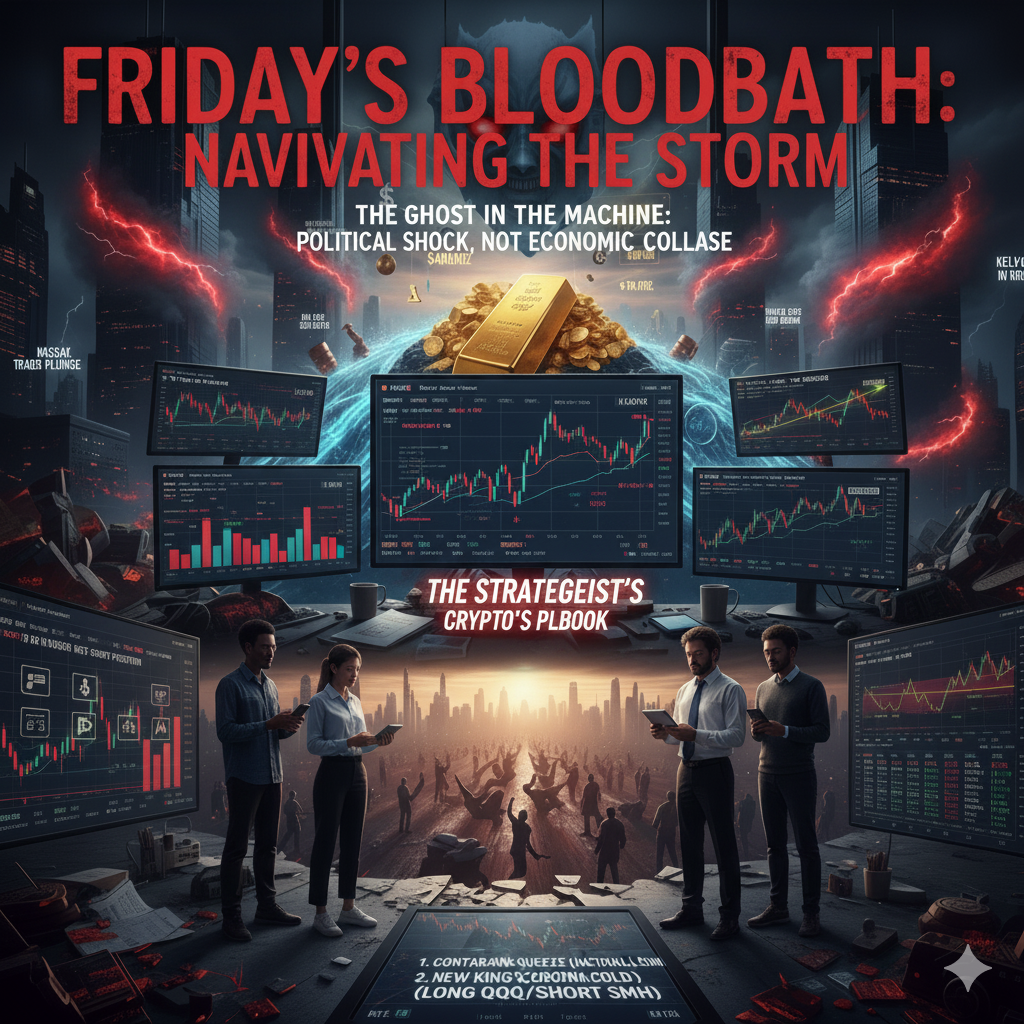SStill not a recession, Yet!

Scribed by Mr. Derrick Macharia
October 14, 2025 • In the Sacred Halls

Hello again, family.
If Friday’s market felt like a sudden, violent plunge in a faulty elevator, I want you to know you're not wrong. The alarms wailed, the floor dropped out, and the G-force of the sell-off pinned us all to the wall. The immediate, human reaction is sheer terror.
But now, the elevator has stopped (for the weekend, at least). The emergency lights are flickering. This is the moment where panic subsides and strategy begins. As your financial engineer, I’ve spent the last 48 hours not just looking at the wreckage, but analyzing the blueprints of the entire building. And what I've found is that this wasn't a random mechanical failure. This was a deliberate, fear-driven event.
And it has created one of the most asymmetric, opportunity-rich environments I have seen all year.
This isn’t your typical market analysis. We're going deeper. We're going to deconstruct the very engine of this sell-off, look at the ghost in the machine, and lay out a high-level playbook for what comes next.
Let’s get to work.
The Anatomy of a Panic - It's Not the Economy.
First, let's be crystal clear about what Friday was, and what it wasn't.
This was not the beginning of a 2008-style, slow-motion economic collapse. This was a policy-driven financial heart attack. The catalysts were distinct and political: a severe escalation in the U.S.-China trade war and the growing chaos of a potential U.S. government shutdown.
This distinction is everything. A failing economy is a chronic disease that slowly eats away at the market. A political shock is an external, acute trauma. The patient is bleeding, but the underlying organs are still functional. The market is not pricing in a recession; it is pricing in purgatory—an indefinite period of political uncertainty.
This has created two massive, quantifiable dislocations that scream opportunity.
1. The Insurance Scam: Decoding the VIX
Wall Street's "fear gauge," the VIX, exploded by over 30% on Friday. But looking at the VIX alone is like looking at only the speedometer of a car. The real story is in the VIX term structure—the price of fear over time.
Right now, the curve is in a state called steep contango.
- In plain English: The market is charging an enormous premium for future volatility insurance. Think of it like this: the price to insure your portfolio against a crash in December, January, and February is extremely high. But the price for insurance today is significantly lower.
- What this tells us: This isn't a state of all-encompassing, present-tense panic. If it were, the curve would be inverted (backwardated), with today's insurance being the most expensive. Instead, this is a market terrified of a future event—a full-blown trade war, a prolonged shutdown.
- The Hidden Cost for Bears: This structure creates a "cost of carry" for anyone betting on a downturn. The ETFs and futures products used to short the market or hedge portfolios are constantly selling cheaper, near-term insurance and buying more expensive, future-dated insurance. This process creates a systematic, daily financial bleed. The market is charging bears a heavy price to maintain their positions. If the bad news doesn't get worse, these expensive hedges will be unwound, providing a powerful tailwind for stocks.
2. The Crowded Theater: Where the Hedge Funds Are Hiding
This is the single most important piece of data right now. The latest Commitment of Traders (COT) report, which shows us how different players are positioned, reveals a staggering imbalance.
Large Speculators (i.e., hedge funds) are holding a historically massive net-short position in S&P 500 futures.
Imagine a theater where 90% of the audience is crowded around one small exit door, all betting the building will catch fire. This is an incredibly fragile and unstable situation. The market has become a coiled spring, wound tight by leverage and a single, crowded narrative of doom.
All it takes is one piece of non-negative news—a tweet about renewed talks, a temporary funding bill—to yell "false alarm." The ensuing stampede to buy back those shorts to avoid catastrophic losses would create a self-reinforcing upward spiral.
This isn't a possibility; it is a mathematical probability under the right conditions. The stage is set for one of the most violent short squeezes of the year.
The Strategist's Playbook for the Storm
Given this landscape, a passive "wait and see" approach is the riskiest of all. This market demands a proactive, multi-faceted strategy. Here are four specific, institutional-grade approaches to navigate the coming week.
The Contrarian Squeeze (Tactical Long)
- Thesis: The extreme short positioning has created a powder keg. Any positive catalyst, however small, could ignite a violent rally. This is a high-conviction, tactical trade designed to capture that asymmetry.
- The Play: Using leveraged instruments like S&P 500 futures (/ES) or Nasdaq futures (/NQ), or call options on the SPY/QQQ ETFs. The goal is to get long exposure upon confirmation that Friday's lows are holding, positioning for a sharp, multi-day snap-back rally. The risk is clearly defined (a stop-loss just below Friday's low), while the reward is a potential recapture of 50% or more of the recent decline.
The Prudent Hedge (Riding the Fear Wave)
- Thesis: The risks are real. Respected leaders like Jamie Dimon are assigning non-trivial probabilities to a major crash. It would be irresponsible not to have a plan for this scenario.
- The Play: Forget the decaying, leveraged inverse ETFs like SQQQ for anything longer than a day. A more sophisticated approach is using an options strategy like a Bear Call Spread. This involves selling a call option far above the current market price and buying another one even further out.
- Why it's smarter: You get paid an upfront premium to make a bet that the market won't rally past a certain high level by a specific date. You profit from fear, time decay, and a falling market, and your maximum loss is strictly defined from the start. It is an intelligent, probabilistic way to hedge.
The New King's Coronation (Structural Long Gold)
- Thesis: Gold's rally above $4,000 isn't just a flight to safety; it's a regime change. For years, U.S. Treasury bonds were the ultimate haven. But with mounting concerns over U.S. deficits, global central banks are aggressively diversifying their reserves into gold. They aren't just hedging; they are systematically de-dollarizing.
- The Play: This is not a tactical trade; it is a core portfolio allocation. Using Gold Futures (/GC) or the Gold ETF (GLD), we buy on dips, not chase highs. The powerful breakout to all-time highs, supported by massive institutional flows, suggests this is a durable, long-term trend. Gold is no longer just an inflation hedge; it is the premier geopolitical haven asset.
The Geopolitical Scalpel (The Semi Bifurcation)
- Thesis: The U.S.-China conflict is not a blanket risk; it is a targeted one. The semiconductor industry is Ground Zero, with China controlling the rare earth materials needed for manufacturing. This has created a specific, measurable "geopolitical risk premium" on these stocks. We can isolate and profit from this.
- The Play: A market-neutral pairs trade. We go Long the QQQ (broader tech, dominated by software and less-exposed giants) and simultaneously go Short the SMH (the semiconductor ETF, highly exposed to the direct conflict).
- Why it's brilliant: This trade is designed to be profitable regardless of whether the market goes up, down, or sideways. Its success depends only on the relative performance of QQQ over SMH. Given the targeted headwinds facing chipmakers, this is a high-probability bet that generates alpha independent of the broader market chaos.
Commander's Intent
The market is balanced on a knife's edge. But the quantitative data is telling us a story that contradicts the screaming headlines. It speaks of a market more vulnerable to a sudden rally than a sustained crash, a structural shift towards gold, and specific, exploitable risks in niche sectors.
The highest conviction setup for Monday is positioning for the contrarian short squeeze. The fear is palpable, but the positioning is too extreme to ignore.
This is not a time for emotion. It is a time for mathematics, for discipline, and for understanding the deeper structures at play. Prepare your positions, define your risk, and get ready to act. In the eye of the storm, clarity is your greatest weapon.
Scribe's Mark of Tomorrow
🏺Mr. Derrick Macharia
*Keeper of Emerging Wisdom*
AI Engineer @Pawanax
📜Share What's Next📜
Related Future Scrolls
📚*Discover more wisdom from the Royal Library's collection*
A comprehensive Analysis of Kenya's Economy
"There is a comforting myth many developing countries tell themselves: “What happens in Washington is far away. We have our own problems.” Kenya, like most emerging economies, knows this is not true — but still underestimates how deeply American fiscal de..."
Mr. Derrick Macharia
The best AI companies in Kenya
"Unlocking the Trillion-Dollar Potential of Kenya’s Sovereign AI Revolution (2025-2030) 1. The Tectonic Shift in the Silicon Savannah The narrative of African technology has, for the better part of two decades, been monopolized by a single story: Fintech...."
Mr. Derrick Macharia
Kenya Venture Capital & Market Intelligence Report 2025-2030
"Strategic Investment Thesis, Revenue Rankings, and Sectoral Alpha 1. The Antifragility of the Silicon Savannah The Kenyan capital markets and venture ecosystem have entered a distinct phase of maturation, decoupling from the speculative volatility that c..."
Mr. Derrick Macharia
Join the Circle of Tomorrow
"Receive future-focused healing insights as the Muses whisper what’s next to your chamber."
Join the sacred circle of healers • Unsubscribe with a whisper to the wind